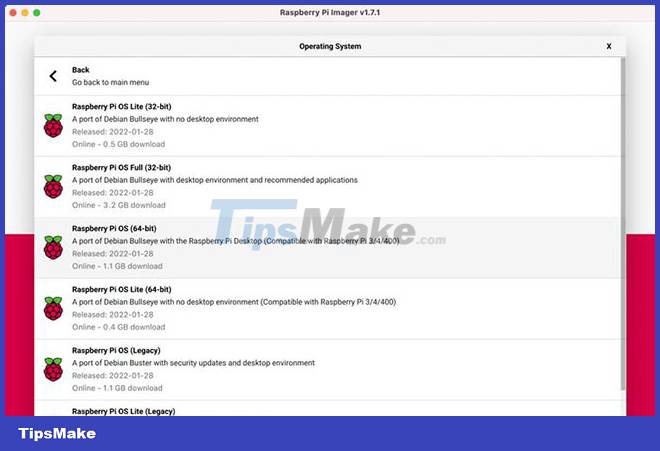What can be done with the 64-bit version of Raspberry Pi OS?
In today's post, TipsMake will look at the advantages and disadvantages, as well as some use cases for the 64-bit version of Raspberry Pi OS.
Prerequisites
To get started, you will need a Raspberry Pi model with a 64-bit processor:
- Raspberry Pi 4B
- Raspberry Pi 400
- Raspberry Pi 3B
- Raspberry Pi 3B+
- Raspberry Pi 3A+
- Raspberry Pi Zero 2 W
- Raspberry Pi CM3
- Raspberry Pi CM3+
- Raspberry Pi CM4
In addition, you also need a microSD card with at least 8GB of storage to install the operating system.
You can then download and use the official Raspberry Pi Imager tool on another computer and select the 64-bit version of Raspberry Pi OS (standard or Lite) in the menu to record to the inserted microSD card .
How to install Raspberry Pi OS 64-bit version
Previously, if you wanted to try the beta version of the 64-bit Raspberry Pi operating system, you needed to download its image file from an archive. Thankfully, the 64-bit Raspberry Pi OS is now fully loaded into the menu of the official Raspberry Pi Imager microSD card recording utility.
Download Raspberry Pi Imager here.

After downloading and installing the latest version of Raspberry Pi Imager on another computer, open it and do the following:
- Click Choose OS, then select Raspberry Pi OS (other).
- Choose Raspberry Pi OS (64-bit) or Raspberry Pi OS Lite (64-bit) - Lite version without desktop interface.
- Click Choose Storage and select your attached microSD card (usually named 'Generic Storage Device Media').
- Click Write to write the operating system image to the microSD card. Note that this will delete any existing data on it.
Once done, remove the microSD card, then insert it into the Raspberry Pi and boot it up. Your Raspberry Pi will now use the 64-bit Raspberry Pi OS and be able to run 64-bit applications, such as [email protected]
How to use Raspberry Pi OS 64-bit
With the 64-bit operating system written to the microSD card, insert it into the Raspberry Pi and boot. Your Raspberry Pi will now use the 64-bit Raspberry Pi OS and be able to run 64-bit Linux applications with the ARM64 (aka AArch64) architecture. Since the Raspberry Pi operating system is based on Debian, this means you can install and run any standard Debian ARM64 package on the 64-bit version of the operating system.
Use cases include running applications that do not currently have a 32-bit version or are not fully optimized for 32-bit. For example, you need to use Raspberry Pi OS 64-bit to run client software for the project [email protected] You can also install BOINC software to participate in many distributed computing projects. Other 64-bit-only applications include Elasticsearch and Presearch.

Increasing productivity
Owners of the flagship Raspberry Pi 4 model with 8GB of RAM can now allocate all memory to a single process - previously limited to 3GB per process on the 32-bit version. So, removing this limitation could be beneficial for certain use cases, such as servers, that require large amounts of RAM.
On all compatible Raspberry Pi models, you can see some performance improvements from using the ARM64 instruction set with the 64-bit SoC, as reported in Phoronix's benchmark tests. Whether these will help improve real-world usage is still up for debate, but some users have reported noticeable speed increases.
Disadvantages of Raspberry Pi OS 64-bit
Some applications, such as Mathematica, are not currently available in the 64-bit version of the Raspberry Pi OS.
Another minor drawback is that the default 64-bit version of the Chromium web browser does not have a version for the WidevineCDM library used with DRM. This means it cannot be used to play media content from popular streaming sites like Netflix, Disney+, Hulu, HBO Go, Amazon Prime, Spotify, and Pandora.
However, this problem can be easily solved by replacing the 64-bit Chromium with the 32-bit version. Just open a Terminal window and enter this command:
sudo apt install chromium-browser:armhf libwidevinecdm0
Now, you know how to install and use the 64-bit Raspberry Pi OS operating system. You will be able to install any standard Debian application with the ARM64 architecture, giving you access to a wider range of software. You may also notice improved performance in some use cases.
Alternatively, you can choose to install another 64-bit operating system on your Raspberry Pi, such as a 64-bit version of Ubuntu, Manjaro, or Alpine Linux.
You should read it
- What's New in Raspberry Pi OS 11?
- 5 ways to make good use of Raspberry Pi 4
- What is the Raspberry Pi and how is the Raspberry Pi used?
- How to start Raspberry Pi 3 from USB
- Why should people try Raspberry Pi 4?
- Learn Pi Imager, How to Use Raspberry Pi Imager
- How to use Raspberry Pi Imager to install Raspberry Pi OS
- Raspberry Pi 4 officially launched, quad-core Cortex-A72 1.5 GHz, maximum RAM of 4GB
May be interested
- How to start Raspberry Pi 3 from USB
 raspberry pi is a great, versatile software suite, with a variety of capabilities like running a media center or using as a radio.
raspberry pi is a great, versatile software suite, with a variety of capabilities like running a media center or using as a radio. - Why should people try Raspberry Pi 4?
 the new raspberry pi 4 has been released, but do you need to upgrade? is raspberry pi 4 really offering more features than the previous raspberry pi 3 b +?
the new raspberry pi 4 has been released, but do you need to upgrade? is raspberry pi 4 really offering more features than the previous raspberry pi 3 b +? - Raspberry Pi AI Kit: Bring AI to Raspberry Pi
 the raspberry pi ai kit is essentially raspberry pi's new m.2 hat+ board integrated with the hailo-8l acceleration module.
the raspberry pi ai kit is essentially raspberry pi's new m.2 hat+ board integrated with the hailo-8l acceleration module. - Learn Pi Imager, How to Use Raspberry Pi Imager
 the raspberry pi foundation recently released a new application for recording sd cards for the raspberry pi. the new program, called raspberry pi imager, launches march 5, 2020.
the raspberry pi foundation recently released a new application for recording sd cards for the raspberry pi. the new program, called raspberry pi imager, launches march 5, 2020. - The upcoming 25 USD Raspberry Pi computer model in Europe
 on february 4, the raspberry pi foundation announced that they had just released a cheaper version of the 'tiny' raspberry pi computer to the european market, and not long after that they would arrive in places. remaining in the world.
on february 4, the raspberry pi foundation announced that they had just released a cheaper version of the 'tiny' raspberry pi computer to the european market, and not long after that they would arrive in places. remaining in the world. - How to use Raspberry Pi Imager to install Raspberry Pi OS
 raspberry pi foundation recently released a new app for burning sd cards for raspberry pi. the new program, called raspberry pi imager, launched on march 5, 2020.
raspberry pi foundation recently released a new app for burning sd cards for raspberry pi. the new program, called raspberry pi imager, launched on march 5, 2020. - Raspberry Pi computer with 5 megapixel camera
 on monday, the raspberry pi foundation released a cheaper version of the model a model of the popular raspberry pi computer.
on monday, the raspberry pi foundation released a cheaper version of the model a model of the popular raspberry pi computer. - 7 best Raspberry Pi 4 cases
 although the raspberry pi 4 is quite small, that doesn't mean you shouldn't equip it with an appropriate 'home'. here are the 7 best raspberry pi 4 cases you can buy right now.
although the raspberry pi 4 is quite small, that doesn't mean you shouldn't equip it with an appropriate 'home'. here are the 7 best raspberry pi 4 cases you can buy right now. - How to set up Raspberry Pi
 you may need some extra hardware and software for many of these projects, but the raspberry pi is still a great base.
you may need some extra hardware and software for many of these projects, but the raspberry pi is still a great base. - What is the difference between Raspberry Pi 4 and other models?
 raspberry pi 4 is a game changer. here's what you need to know about pi 4 and how this model is different from the previous raspberry pi 3b +.
raspberry pi 4 is a game changer. here's what you need to know about pi 4 and how this model is different from the previous raspberry pi 3b +.









 What's New in Raspberry Pi OS 11?
What's New in Raspberry Pi OS 11? What can you do with the Raspberry Pi 400?
What can you do with the Raspberry Pi 400? 8 best lightweight operating systems for Raspberry Pi
8 best lightweight operating systems for Raspberry Pi How to use zram with Raspberry Pi
How to use zram with Raspberry Pi Fix Raspberry Pi not connecting to WiFi / Ethernet
Fix Raspberry Pi not connecting to WiFi / Ethernet How to install Caliber Content Server on Raspberry Pi
How to install Caliber Content Server on Raspberry Pi